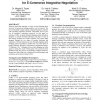2097 search results - page 377 / 420 » Modeling and Simulation of Hardware Software Systems with CD... |
EUROSYS
2007
ACM
14 years 6 months ago
2007
ACM
Virtual memory has been successfully used in different domains to extend the amount of memory available to applications. We have adapted this mechanism to sensor networks, where,...
GECCO
2009
Springer
14 years 3 months ago
2009
Springer
Software agents help automate a variety of tasks including those involved in buying and selling products over the internet. The need for handling complex highly configurable produ...
MST
2011
13 years 4 months ago
2011
In this paper we generalize the Continuous Adversarial Queuing Theory (CAQT) model [5] by considering the possibility that the router clocks in the network are not synchronized. W...
SASN
2006
ACM
14 years 3 months ago
2006
ACM
Intrusion or misbehaviour detection systems are an important and widely accepted security tool in computer and wireless sensor networks. Their aim is to detect misbehaving or faul...
PLDI
2009
ACM
14 years 4 months ago
2009
ACM
Decentralized information flow control (DIFC) is a promising model for writing programs with powerful, end-to-end security guarantees. Current DIFC systems that run on commodity ...

